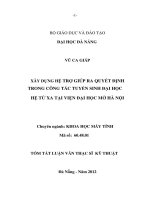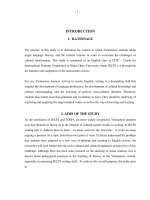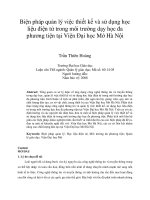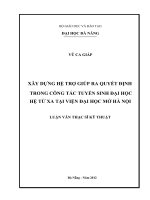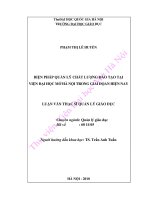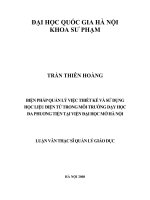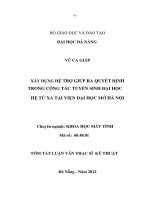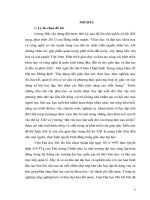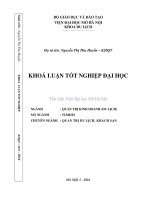Chuyển di văn hoá trong bài thi viết 2 của IELTS tại viện đại học mở hà nội
Bạn đang xem bản rút gọn của tài liệu. Xem và tải ngay bản đầy đủ của tài liệu tại đây (440.63 KB, 71 trang )
- 1 -
1. RATIONALE
The purpose of this study is to determine the context in which Vietnamese students attain
target language literacy, and the cultural transfer in order to overcome the challenges of
cultural interferences. This study is conducted in an English class at CITC – Centre for
International Training Cooperation at Hanoi Open University, where IELTS is a prerequisite
for entrance and completion of the mainstream courses.
For any Vietnamese learners striving to master English, writing is a demanding skill that
requires the development of language proficiency, the development of cultural knowledge and
cultural understanding, and the fostering of positive cross-cultural attitudes. Therefore,
students have much more than grammar and vocabulary to learn. They should be underway of
exploring and acquiring the target cultural values as well as the way of knowing and learning.
2. AIMS OF THE STUDY
As the certificates of IELTS and TOEFL are more widely recognized, Vietnamese students
now find themselves facing up to the obstacle of cultural transfer mostly in writing. In IELTS
writing task 2, students have to learn – in many cases for the first time – to write an essay
arguing a position on a topic from their own point of view. To better understand the problem
that students have adjusted to a new way of thinking and learning in English classes, the
researcher will look further into the socio-cultural and cultural pragmatics perspectives of this
challenge. Although there has been some research on the studying of Asian students, less is
known about pedagogical practices in the teaching of literacy in the Vietnamese context,
especially in mastering IELTS writing skills. To achieve this overall purpose, the study aims
to
- 2 -
• Investigate and identify typical mistakes relating to cultural thought patterns that
Vietnamese students tend to make.
• Compare, contrast and clarify some similarities and differences in writing styles in
Vietnamese and English culture.
• Propose some suggestions and implications for teaching and learning IELTS writing
task 2 for Vietnamese students.
The focus of the investigation would be the prior knowledge the students had acquired about
literacy that would be transferred to the second language classroom. In order to achieve the
above objectives, three following research questions will be addressed:
(1) What are the typical mistakes relating to culture of Vietnamese students
in writing IELTS task 2?
(2) Why do they make such mistakes?
(3) How can the mistakes be overcome?
3. METHODS OF STUDY
Research might benefit those who teach students, enabling them to better address educational
difficulties related to the cultural transmission. With these ideas in mind, the researcher
studies a class at HOU with the purposes of observing an English class in the Vietnamese
context.
Multiple research methods of qualitative research design, including interviews, observation,
and document analyses have been employed in this study. The research questions that the
study will answer relate to the following areas: the participants’ writing mistakes when
completing IELTS task 2 of writing, how these mistakes relate to cultural elements, why
students make those mistakes and how this problem can be solved.
The utilization of qualitative methods was justified by the nature of the research questions
mentioned earlier in Chapter One, Part 2 that required that the researcher approach human or
- 3 -
human-related resources to answer these questions. Glossner (1990) believes that “[the]
richness and complexity of students’ attitudes toward learning might be better understood
through qualitative research techniques than quantitative research techniques” (p. 16). Thus,
the use of qualitative research in this study was appropriate since it took place in a natural
setting and depended on data collection methods that were based on words rather than on
numbers.
The role of the researcher is that of participant observer, sharing class work and homework,
collecting all writing done in class, interviewing students and lecturer before and after class.
In other words, the researcher became both an insider and outsider in order to both understand
the students’ experience and evaluate it objectively as an observer. Being guided by the
preceding research questions, all the data were carefully reviewed and analyzed for salient
themes which would help create a finely grained description of the class in order to better
understand the entering freshman’s perspectives on learning language, specifically writing
skills.
The main techniques of carryong out the research are:
Interviewing students and teachers
Taped transcripts
Collecting writing pieces of students
Document analyis
Observation
4. LIMITATION OF THE STUDY
Because of the limit of time, the research paper focus on the cultural aspects of Vietnamese
students’ writing scripts of IELTS task 2 at CITC - HOU. All the texts are marked, identified,
and analyzed to find the common errors involved with the cultural elements. In the future, if
possible the researcher would like to develop the study to include the videotapes of teacher’s
- 4 -
manner of conducting the class that affects the way students complete their tasks. The
underlying reason is that cultural transfer partly stems from human interaction; in this area of
study that is the interaction between lecturer and students, in the context of a classroom.
5. DESIGN OF THE STUDY
The thesis begins with acknowledgements, table of contents.
The main body is divided into 3 parts:
- The first part is Introduction to the study
- The second part, Development, consists of three chapters:
o Chapter I discusses the theoretical preliminaries in which the emphasis is laid
on the definition of Transfer, Writing, IELTS test and assessment criteria
o Chapter II, the main chapter of the research, describes the research procedure,
data collection and techniques as well as data analysis
o Chapter III presents a variety of cultural transfer in completing IELTS writing
task 2, including near and far transfer, positive and negative transfer.
- The third part, conclusion is the review of the study.
Bibliography puts the end to the study.
- 5 -
I.1. Language, culture transfer, definition and categories
There have been lots of definitions and concepts about culture so far. In this study, the term
culture includes such aspects as attitudes and ways of thinking and writing, and the social
knowledge that person uses to interpret experience. In other words, culture should be seen as
the framework of assumptions, ideas, and beliefs that are used to interpret other people's
actions, words, and patterns of thinking. However, it is crucial that foreign language learners
should become aware of differing cultural frameworks, both their own and those of others;
otherwise they will use their own cultural system to interpret target-language messages whose
intended meaning may be well be predicated on quite different cultural assumptions.
According to Martin (1993), in the fields of social psychology and studies of communication,
cultural competence is seen in social effectiveness (i.e. the ability to achieve instrumental and
social goals) and appropriateness (i.e. suitable communication in a given situation in a
particular culture). The term has been defined in foreign language learning as "the ability of a
person to behave adequately in a flexible manner when confronted with actions, attitudes and
expectations of representatives of foreign cultures" (Meyer, 1991, p. 137).
On one hand, human culture, social behaviour and thinking would not exist without language
as Edward Sapir (1985: 171) stated, “ Language actually shapes the way which we perceive,
think, and therefore act”. On the other hand, transfer means exchange procedure between two
cultural areas (i.e. between Germany and English or between France and Russia). Thus,
culture transfer can be defined in the comparison with ordinary learning.
I.1.1. Transfer versus ordinary learning
According to David N. Perkins and Gavriel Salomon in their contribution to the International
Encyclopaedia of Education in 1992, any learning in a sense requires a modicum of transfer.
- 6 -
To say that learning has occurred means that the person can display that learning later. Even if
the later situation is very similar, there will be some contrasts perhaps time of day or the
physical setting. So no absolute line can be drawn between ordinary learning and transfer.
However, transfer only becomes interesting as a psychological and educational phenomenon
in situations where the transfer would not be thought of as ordinary learning. For example, a
student may show certain grammar skills on the English test (ordinary learning) but not in
everyday speech (the hoped-for transfer). The student may solve the problems at the end of
the chapter (ordinary learning) but not similar problems when they occur mixed with others at
the end of the course (the hoped-for transfer). In other words, talk of transfer is always at least
implicitly contrastive: it assumes learning within a certain context and asks about impact
beyond that context.
I.1.2. Positive versus negative transfer
Positive transfer occurs when learning in one context improves performance in some other
contexts. For instance, speakers of one language find it easier to learn related than unrelated
second languages. Negative transfer occurs when learning in one context impacts negatively
on performance in another. For example, despite the generally positive transfer among related
languages, contrasts of pronunciation, vocabulary, and syntax generate stumbling blocks.
Learners commonly assimilate a new language's phonetics to crude approximations in their
native tongue and use word orders carried over from their native tongue.
While negative transfer is a real and often problematic phenomenon of learning, it is of much
less concern to education than positive transfer. Negative transfer typically causes trouble
only in the early stages of learning a new domain. With experience, learners correct for the
effects of negative transfer. From the standpoint of education in general, the primary concern
is that desired positive transfers occur.
- 7 -
I.1.3. Near versus far transfer
Near transfer refers to transfer between very similar contexts, for instance, when students
taking an exam face a mixture of problems of the same kinds that they have practiced
separately in their homework, or when a garage mechanic repairs an engine in a new model of
car, but with a design much the same as in prior models. Far transfer refers to transfer
between contexts that, on appearance, seem remote and alien to one another. For instance, a
chess player might apply basic strategic principles such as “take control of the centre” to
investment practices, politics, or military campaigns. It should be noted that “near” and “far''
are intuitive notions that resist precise codification. They are useful in broadly characterizing
some aspects of transfer but do not imply any strictly defined metric of “closeness”.
I.1.4. Prospects of transfer
As noted earlier, transfer is especially important to learning theory and educational practice
because very often the kinds of transfer hoped for do not occur. The renowned educational
psychologist E. L. Thorndike conducted the classic investigation of this in the first decades of
the 20
th
century. Thorndike examined the proposition that studies of Latin disciplined the
mind, preparing people for better performance in other subject matters. Comparing the
performance in other academic subjects of students who had taken Latin with those who had
not, Thorndike (1923) found no advantage of Latin studies whatsoever. In other experiments,
Thorndike and Woodworth (1901) sought, and generally failed to find, positive impact of one
sort of learning on another. Thorndike concluded that transfer depended on “identical
elements” in two performances and that most performances were simply too different from
one another for much transfer to be expected. In terms of the rough near-far distinction, near
transfer is much more likely than far transfer.
Thorndike's early and troubling findings have re-emerged again and again in other
- 8 -
investigations. For instance, the advent of computer programming as a school subject matter
stimulated the proposal that computer programming developed general problem solving skills,
much as Latin was thought to cultivate mental discipline.
Another learning experience that might impact broadly on cognition is literacy, the mastery of
reading and writing. Wide-ranging transfer might be expected from experience with the
cognitive demands of reading and writing and the cognitive structures that text carries.
However, Scribner and Cole (1981) reported a study of an African tribe, the Vai, with an
indigenous form of writing not accompanied by schooling. Using a variety of general
cognitive instruments, they found no differences between the Vai who had mastered this
script and others who had not. They argued that the impact of literacy depends on immersion
in diverse activities surrounding literacy, not on acquisition of reading and writing per se. The
Vai only employed their script in a very specific way, in contrast with the many uses of
literacy apparent in many cultures.
It is not clear whether one should consider study of problem isomorphs near or far transfer,
because isomorphs are near identical structurally but very different in external trappings. In
any case, subjects usually do not recognize the connection between one isomorphs and the
other and hence do not carry over strategies they have acquired while working with one to the
other. However, if the relationship is pointed out, then subjects can do so fruitfully (Simon
and Hayes 1977).
I.2. What is writing?
I.2.1. What is writing?
The question has raised a variety of ways to answer according to the level of the learners. At
one level, writing can be said to be" the act of forming graphic symbols on a flat surface of
- 9 -
some kind". But for the learners of higher level, it is much more than the production of these
symbols, just as speech is not simply the production of sounds, the symbols have to be
arranged to form words, and words have to be arranged to form sentences. However, they are
not unrelated sentences, they must be joined together to form what is called 'a text'. So to the
learners at this level, writing means producing" a sequence of sentences arranged in a
particular order and link together in a certain ways" (Byrne: 1991).
At a high level, in academic education, writing has been defined as a creative process, which
requites some preparation, drafting and revising. Oshima, A. & Hogue, A. (l999) and Brown,
K. & Hood, S. (l992) suggested a practical writing process as follows:
Figure 1: Process of writing
(Source: Brown & Hood 1992: 6)
From another point of view on writing, language teachers consider it as a supportive skill and
as a communicative skill. Students often use writing as a supportive skill when they try to
learn a linguistic system. For example, they copy down learned materials, paying attention to
grammatical features, vocabulary and spelling, and they complete grammar practice exercises
to reinforce their knowledge of structures. As a communicative skill, students can express
their ideas and opinions. They can write about what they are interested in and know about,
what they want to communicate with someone else and what they want a reader to know.
Greater emphasis on communication in the classroom has brought a realization that students
may benefit from earlier exposure to personal and creative writing. One more common view
Preparing
Preparing
Preparing Preparing
Preparing
Preparing
- 10 -
that many language teachers share is that writing is the language skill which is difficult to
acquire since in writing, compared with speech, much higher standard of language, more
careful constructions, more precise and varied vocabulary, more correctness of expression are
demanded.
II.2.2. Why teach writing?
Resting on the view that writing is a skill, which is difficult to acquire, we should be very
clear about the purposes in teaching it. B. Dann (1991) pointed out a variety of pedagogical
purposes as follows:
(a) The introduction and practice of some form of writing enables us to provide for different
learning styles and needs. Some learners, especially those who do not learn easily through
oral practice alone, feel more secure if they are allowed to read and write in the language. For
such students, writing IS likely to be an aid to retention, if only because they feel more at ease
and relaxed.
(b) Written work serves to provide the learners with some tangible evidence that they are
making progress in the language. It is not likely to be a true index of attainment, but once
again it satisfies a psychological need.
(c) Exposure to the foreign language through more than one medium, especially if skills are
properly integrated, appears to be more effective than relying on a single medium alone.
(d) Writing provides variety in classroom activities. For example, it serves as a break from
oral work. And at the same time, it increases the amount of language contact through work
that can be set out of class.
(e) Writing is often needed for formal and informal testing.
I.2.3. What makes an effective writing?
- 11 -
According to Brown, K & Hood, S (1989), effective writings require a number of things, a
high degree of organization in the development of ideas and information, a high degree of
accuracy so that there is no ambiguity of meaning; the use of complex grammatical devices
for focus and emphasis, and a careful choice of vocabulary, grammatical patterns, and
sentence structures to create a style which is appropriate to the subject matter and the eventual
readers.
Nevertheless, producing a good writing remains a challenge for many students. In order to
achieve it, they should be proficient not only in grammar, socio-linguistic, discourse and
strategic competences but also in cultural competences.
I.3. Previous research on writing skills and cultural transfer
Among the four main skills to acquire and master a second language literacy, writing is
conceded by many researchers as being extremely complex. Unlike the receptive reading and
listening tasks, writing requires both social and linguistic knowledge, and skills to be fulfilled.
Especially, writing conducted in a second language does need cultural understanding and
practice.
Interestingly, as it is shown in many existing researches, the concepts of teaching writing vary
widely from culture to culture. Purvis (1992) found through his study that involved students,
teachers, and researchers in fourteen countries that the concept of writing could include a
wide variety of tasks, including note taking, business writing, and summarizing. From east to
west, perceptions toward literacy tasks in the classroom may also vary. According to Song
(1995), East Asians’ need and tend to be submissive to the teachers. This very attitude
stemming from respect to the older people and teachers can hinder critical thinking. Kang,
Kuehn, and Herrell (1994), for example, in their study of Hmong literacy, found that Hmong
students relied heavily on teacher directions and were hesitant to participate in front of peers.
This contrasts strongly with a common request in the required tests into university like IELTS
- 12 -
writing task 2, where candidates are assessed on their linguistic skills as well as critical
thinking and problem-solving to argue the case.
Researchers for a better understanding of bilingualism and the implications for education have
investigated cultural transfer of skills. Odlin (1989) has found out that transfer can be either
positive or negative, relying on many factors like the distance or similarity between aspects of
languages contrasted. However, several studies by Cummins and Swain (1992) suggest that
highly literate bilinguals can have an advantage not just in their linguistic skills but also in
their problem solving skills. A high degree of literacy can affect a positive transfer of both
writing and reading skills. Besides skills, prior knowledge and experience, including
classroom experience, can also be transferred. For example, if the two languages being
compared have different writing systems, transfer would not be possible on the orthographic
level of the languages involved. In a like manner, if the two language literacy classes are
different, the student will have some difficulty transferring what they have learned.
Previous research has examined differences in written discourse across English and Spanish
cultures as they affect transfer. An important study by Montano-Harmon (1991) has described
discourse features (enumeration, addition, summation, result, explication, illustration,
contrast, and transitional words and phrases) in fifty expository essays by four groups of
bilingual Mexican-American high school students. Their texts were marked by repetition of
the ideas several times, with each repetition more formal than the one before it. This is a
stylistic variation interpreted by some researchers as a result of the historic cultural tradition
of spoken poetry and epic literature (Ostler, 1981). The Mexican-American writers
deliberately digressed from the topic, whereas, the Anglo-American writers relied more on
linear rhetoric, using enumeration as a transitional device, such as first, next, then, and after
that.
More recent research has examined rhetorical strategies in student persuasive writing. Ferris
(1989) examined 60 persuasive writing samples, half of which were by native English
- 13 -
speakers and the other half by non-native speakers. He found that the differences between the
two populations might be due to lack of preparation for argument writing. One of the results
of the study was the recommendation for more investigation into the educational background
of ESL students entering as college freshmen, especially with respect to learning to write
persuasive discourse.
Aside from differences in rhetorical styles, social construction of knowledge within discourse
communities has become an important area of research (Leki, 1991) since these constructs
can transfer to the second language literacy acquisition process. Socialization styles in the
classroom vary from culture to culture; students often come from classrooms in which
interaction between peers and between students and teachers is nonexistent. Instead, teacher-
dominated environments tend to be the rule in some of the cultures studied (Ramirez, Yuen,
Ramey, and Pasta, 1991).
I.4. Vietnamese traditional class and writing styles
Under the immense influence of Confucianism and especially Chinese literature for more than
a thousand years, Vietnamese literary development has gone through lots of transfer and
assimilation. In Vietnamese traditional idea three people that always deserve respect are the
king, the father, and the teacher. In that ideology, people must follow those people’s advice
and even die for them if necessary. Thus, the traditional class is a model of a teacher sitting in
front of all students, talking and enjoying the supreme power in the setting. Students were
supposed to attentively listen and take notes, with very limited contribution to the whole
process of teaching and learning. In other words, students take passive role in the whole
process of learning, as they are supposed to be inferior to the teachers and to follow the
teacher’s model. This somehow stems from the learning and teaching styles that have
dominated Vietnamese classes for a considerable length of time. The model of Vietnamese
students learning English has a lot in common with Chinese one, as Byram.M and Fleming.M
(1998):
- 14 -
Figure 2: A Chinese cultural model of learning English
Another point to be considered is Vietnamese writing style, which was centred on epics and
poems. Argumentative writing was not encouraged until the development of modern
Vietnamese literature in the beginning of the twentieth century, with some famous critics like
Hoai Thanh, Hoai Chan… In the syllabus of literature for twelve years’ undergraduate,
Vietnamese students are familiar with some kinds of argumentative writings for a poem, a
story or a novel. Sadly though, their ideas are under influence of so many previous critics or
their own teachers that normally, they follow some fixed styles or opinions. Any other ideas
are regarded as strange and inappropriate. This has many causes, though, partly from
teachers’ teaching styles, and partly from students themselves. But this controversial issue has
attracted lots of attention recently when a girl student wrote in her exam that she couldn’t see
any beauty in a famous poem by a Vietnamese patriot in the war against French colony. This
was a shocking idea, as generations of teachers and students have had to follow that model of
thinking about the beauty of that poem!
TEACHER TEXTBOOK
mastery of
knowledge
STUDENTS
transmission
grammar
vocabulary
Language
learning focus
- 15 -
I.5. The relationship between writing and culture
The relationship between writing and culture can be described as that of a component and an
assembly to which it belongs (“culture” hereby covers the way of life, including knowledge,
arts, beliefs, social conventions, or customs…). Their relationship can also be envisioned as
that of a component and the others in the assembly. The nature of these relationships can be
characterized as interactive and multi-dimensional.
Language, writing and culture have been in a close relationship, as language is a means of
writing to express oneself, his (her) own dreams and passions, his (her) surroundings and
culture. Writing, as one of the most fundamental means of communication of human beings,
is not merely a system of marks, which record spoken language. It includes all recording
systems, not just text, but also graphics, maps, numeracy, databases and represents the
elements of the culture that it belongs to. Chinese writing and literature, for instance, would
differ from American one, in terms of tradition, customs, and festivals of each culture.
Culture and communication are inseparable because culture not only shapes the ways of people
talking to each other, talking to whom, about what, and how the communication proceeds, it
also helps to determine how people encode messages, the meanings they have for messages,
and the conditions and circumstances under which various messages may or may not be sent,
noticed, or interpreted. Culture is the foundation of communication, in which writing
contributes an important part.
The ability to write well is not a naturally acquired skill; it is usually learned or culturally
transmitted as a set of practices in formal instructional settings or other environments. Writing
skills must be practiced and learned through experience.
- 16 -
Writing, as a reflective and communicative activity, pursues a certain purpose or goal. This
purpose determines the writing styles, strategies and skills to be used in order to produce an
adequate and appropriate writing. Writing is a part of literacy that reflects the ways of
thinking of a defined culture. As it can be seen, while Vietnamese people tend to think in a
spiral model, English ways of thinking is in the shape of a straight line.
Anglo-
European
Semitic Oriental Romance Russian
Figure 3: Kaplan’s model of thinking
“Linearity” (Anglo-Saxon)
"Parallelconstruction" with the first idea completed in the second part (Semitic)
"Circularity" with the topic looked at from different tangents (Oriental)
"Freedom" to digress and introduce 'extraneous' material (Romance)
"Amplification” - similar to “Freedom” but with different lengths and parenthetical
amplifications of subordinate elements.
In 1966, Robert Kaplan, in "Cultural Thought Patterns in Cultural Education," analyzed the
organization of individual paragraphs in approximately six hundred compositions by ESL
(English as Second Language) students and sought to identify rhetorical differences in their
writings to contrast with rhetorical characteristics in English paragraph development. His
essay thus pioneered an area of study that is now known as "contrastive rhetoric." Altogether
- 17 -
he identified five types of paragraph development for five cultural groups, and each type
reflects a corresponding culture's thought patterns. For example, paragraph development in
Anglo-European expository writing follows a linear path, whereas speakers of Semitic
languages construct paragraphs based on a complex series of parallel constructions. Oriental
writing, on the other hand, can be characterized by an indirect approach as its paragraphs are
"turning and turning in a widening gyre" (10). In Romance languages and in Russian,
paragraphs allow for a degree of digressiveness - one that could be overbearing to a writer of
English.
Contrastive rhetoric with its primary goal of studying ESL and EFL (English as a Foreign
Language) writing across languages and cultures is a sub field of applied linguistics,
contrastive rhetoric does not set out to study individual rhetorical traditions and their practices
in their own times and places.
Moreover, writing IELTS task 2 takes place in concrete, definable situations, which are
limited in time and space and involve members of different cultures. These situations can be
said to be embedded in given cultures, and include in themselves cultural elements.
In a research carried out by Fox (1994), in which she explores the relationship between
academic writing and culture. Interestingly, one student named Carla, put it very clearly their
resistance to academic writing in the U.S.:
“Learning to write in an American style, it is much more than learning a new
technique. It is a way this culture "normalizes" you to the system, shaping on
you new values and new ways of looking at the world. Therefore, the writing
style is not value free; it has ethical consequences depending on if it is
empowering or dis-empowering for you in this new culture or in your home
culture.” (p. 77)
- 18 -
Writing, in other words, is inextricably bound to culture in the way that it partly expresses
cultural elements like ways of thinking and values, such as traditions, customs and literary
development. The purpose of teaching a foreign language was to enable students to
understand the mind-sets, attitudes, and beliefs of the targeted language, to manage
conversations the way typical natives do, to use literary texts as an opportunity for students to
express themselves and to respond as readers to the ideas contained in the texts.
I.6. General Language Testing
I.6.1. What is a language test?
The first question to answer is then what is a language test. A number of definitions may be
provided that will explain the concept of a test. One definition given by Carroll (1968) is:
“A psychological or educational test is a procedure designed to elicit cream behaviour from
loch one can make inferences about certain characteristics of an individua1.” (Carroll
1968:46).
So a test may be defined as a measurement instrument that gives us a sample of an
individual’s behaviour. The language test may also be defined as a device that tries to
estimate how much the students have learned in a language course; or as an attempt to
produce, interpret or recall certain type of material that was taught by the teacher and learned
by students.
I.6.2. Why do we test?
The second question to answer is why do we test. The reasons for language testing are
diverse. The test is given to the students when there is a need to:
1) Find out about the progress the students have made in the language areas and
skills, which have just been taught
- 19 -
2) Check the understanding of language; this is an indication for the teacher if he
has taught the students
3) Find out about the achievement, how much the students know, how much they
have learned of what should have been taught
4) Find out about difficulties, diaries the specific features of language that the
students may have problem mastering;
5) Encourage the students and increase their motivation, show them the goals they
have already reached and indicate that they are constantly making progress, that they
learn new things and become more fluent;
6) Check the systematicałity of the students and if they work regularly;
7) Find out about the proficiency, how suitable the students will be in performing
certain tasks, how successful they will be in doing their assignments;
8. Place the students according to their language abilities;
9. Grade the students in order to establish if they should be moved on to the next class or
course, or if they should be retained.
I.7. IELTS overview and writing test format
Nowadays, IELTS examination can be taken in over 100 different countries in the world. It is
primarily designed to assess the readiness of candidates to study or train in further or higher
education courses held in English at college or university. The examination takes 2 hours and
45 minutes to complete, and consists of four Sub-tests in the skills of listening, reading,
writing and speaking. There are two IELTS test modules available - the Academic Module
and the General Training Module. The results of the Academic Module may be used to
- 20 -
determine a candidate's suitability for study at undergraduate or postgraduate level. The
General Training Module is suitable for candidates wishing to continue their studies at
diploma level only. The General Training Module is also used for immigration purposes to
Australia or New Zealand, and for students who wish to complete their secondary education
in an English-speaking country. The General Training Reading and Writing Sub-tests are less
demanding than the corresponding Academic Module Sub-tests, but the Listening and
Speaking Sub-tests are the same for both modules. IELTS bands range from 0 to 9, which an
average of the 4 Sub-test Band Scores, with fractional scores rounding up or down to the
nearest.
The Writing Sub-test takes 60 minutes and there are two writing tasks.
The first task will take approximately 20 minutes, and you are required to write a minimum of
150 words. The second task will take approximately 40 minutes with a minimum of 250
words. In both tasks you must write in the formal academic style appropriate to the question
task. You will also be marked on your ability to organise your writing, and on your choice of
content within your answers. The question tasks do not require you to have any specialised
knowledge of a particular subject.
For Task 1 you describe information that is presented to you in a graph, table, chart, diagram,
or short piece of text. The description is usually given in the form of a report. You might have
to compare sets of data, or use a set of data to support a given statement. Alternatively, you
might be required to describe the stages of a process, describe an object, or explain how
something works, or how it is used.
For Task 2 you are asked to write a formal essay or a report in which you might have to offer
a solution to a particular problem, present and justify an opinion, compare information given
in the question task, or evaluate and challenge a given argument, for example:
Present and justify an opinion
e.g. Do you think trial by jury should be used in all criminal cases?
- 21 -
Compare and contrast evidence, opinions and implications
e.g. How effective is it to teach and study with and without computers?
Evaluate and challenge ideas, evidence or an argument
e.g. ‘Failure shows desire wasn’t strong enough’. To what extent do you
agree?
I.8. IELTS writing task 2 - Assessment Criteria and Cultural elements
Each task is assessed independently, and the assessment of task 2 carries more weight than
task1. Task 2 scripts are assessed on performance in the following areas: Arguments, Ideas
and evidence, Communicative Quality and Vocabulary and Sentence Structure. For IELTS
writing task 2, candidates must respond appropriately in terms of:
• Register – formality and politeness; e.g. no short forms
• Organisation – clear and logical
• Style – academic; e.g. no rhetorical questions, no exclamations, no extreme
opinions, use sensative expressions such as ‘this appears to be…’ ‘this is
probably due to…’
• Content – relevant and complete
As mentioned before, this study focuses on the cultural differences that hindrance Vietnamese
students from achieving good result of IELTS writing task 2, therefore the last three
requirements: organisation, style and content will be discussed in details.
I.9. Vietnamese students’ writing IELTS task 2
Even though IELTS has been introduced into Vietnam for about 10 years, it has attracted lots
of attention from students, for whom it is a requirement for overseas study or work. For most
Vietnamese students, writing is a real challenge and also a hindrance on the way to achieve a
high band score. There are, of course, many causes, one of which is the dealing with cultural
thought patterns. To put it simple, the ways of thinking, as can be seen in the section 4,
between two cultures has contributed a great part in causing the breakdown in
communication.
- 22 -
Moreover, writing does require not only linguistic competence but also paralinguistic factors.
Mastering writing skills in general and IELTS writing skills in particular needs a combination
of the two elements: linguistic and culture. For Vietnamese students, cultural factors haven’t
been taken into consideration to a satisfactory extent.
Although there are some studies on Asian populations, there is a specific scarcity of research
on Vietnamese students acquiring an argumentative writing in English, especially in
completing IELTS writing task 2.
- 23 -
II.1. Research procedure
II.1.1. Setting of the Study
This study was conducted at Hanoi Open University, specifically in the Center for
International Training and Cooperation. The center offers a number of IELTS preparation
courses, for students who need to develop their writing ability in order to meet academic
requirements.
I first contacted the instructor of the class and asked her for permission to observe her class
and ask the students to volunteer in this study. The lecturer gave me her full permission to
attend the class at any time. She also provided me with the syllabus for the course. The class
met twice a week throughout a four-month semester. The course was based on the thinking-
writing process, which includes lots of writing skills needed for the IELTS pressure. In this
course, the instructor provided theory of essay writing as well as models of texts, and engaged
students in analyzing and editing class papers, group discussion and peer review, and writing
for specific audiences. The course depended on giving students opportunities to practise
writing task 1 and task 2 of IELTS.
Students were required to complete assigned home writing before each class meets. They
were also required to write one paper and post them on the "WebCT" online bulletin board.
II.1.2. Participants
The participants in this study were ESL undergraduate students who are enrolling in the
foundation courses run by Hanoi Open University in cooperation with Box Hill Institute,
Melbourne, Australia. The ratio of male and female students was 1/2; all of them are
Vietnamese students from different parts of the country. In terms of competence, students are
- 24 -
mostly at intermediate level of English. They all have studied English for at least 5 years in
high schools and have attended a short course on Grammar and Vocabulary before the IELTS
course, which last 12 weeks.
The students enrolled in IELTS preparation course were asked to voluntarily participate in
this study, which aims at analyzing the common mistakes in their writing course.
II.1.3. Purposive Sampling
The number of students enrolled in each IELTS class usually ranges from 18 to 25. I asked all
the students taking this class to voluntarily participate in this study. This study mainly focuses
on their cultural transfer of writing skills throughout this writing course. The study focuses on
providing an appropriately thick description in the context described above.
According to Erlandson, Harris, Skipper, and Allen (1993), the researcher’s main goal is to
obtain purposive and directed sampling that renders a large amount of information. They also
mention two essential criteria for purposive sampling: selection of who and what to study, and
choosing who and what not to study. In my study, I have decided to select the participants
taking this course, since they can best help answer my research questions. I also decided not
to investigate the teachers’ views about the course, because the emphasis of the study is on the
students’ transfer of skills.
Due to the results of the participants’ writing placement tests, the participants were placed in
different groups of the college writing course required for all students. This course aims at
developing their writing ability to meet the requirements of their academic course of study.
Although the participants came from different parts of the country, they shared similar
background information about their L2 learning experiences, in general, and about their
writing experiences, in particular. This section highlights the participants' background
information based on the first interview.
- 25 -
The participants' ages ranged from 18 to 23. Their English learning experiences were limited
to school. The English courses in intermediate and high school were confined to basic
language skills, such as spelling and grammar. They did not have any writing experiences
except for school requirements, which were limited to completing exercises or doing
homework, again largely focused on grammar. This course, ESL College Writing, was their
first and only language course. Table one shows some background information about the
participants:
Table 1- Background Information
Participants Age & Gender Major College Writing
Courses
Nguyen Van Hoa 19 /M Accounting 0
Chu Thanh Mai 21/F Telecom 1
Dang The Dung 20/M
Computer
Science
1
Hoang Thanh 20/F Finance 1
Pham Manh Hoang 22/M Accounting 0
Hoang Anh Thu 20/F Accounting 0
Phan Anh Tuan 21/M
Computer
Science
0
Tran Viet 18/ M
Computer
Science
0
Nguyen Huu Minh 18/M Finance 0
Phan Hai Nhung 18/F Accounting 1
Hoang Thi Hong 18/F Accounting 0
